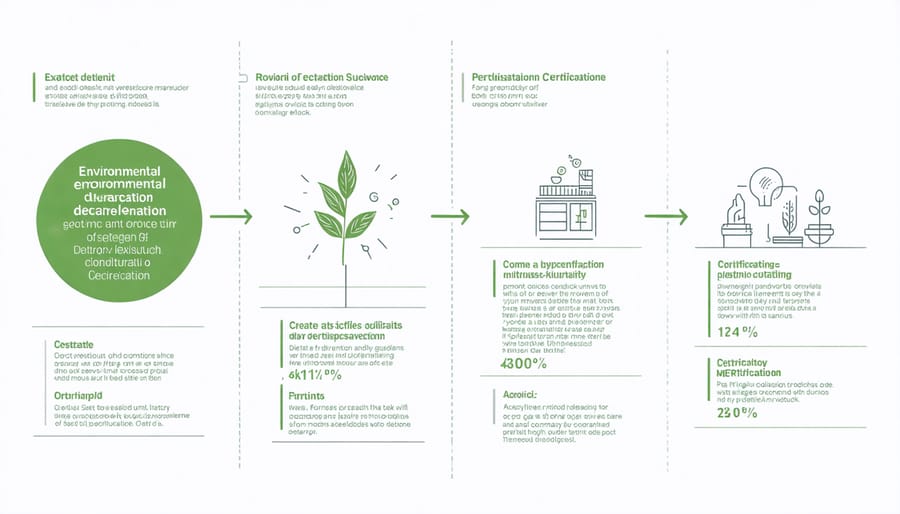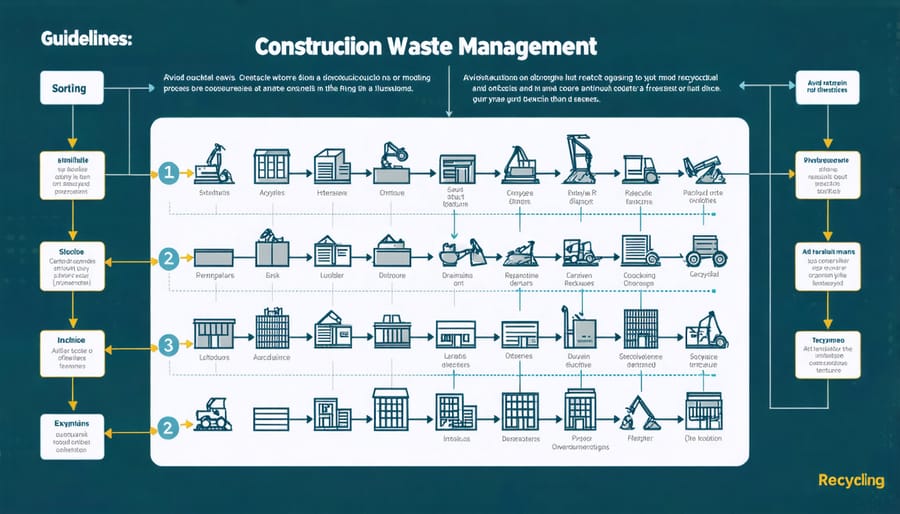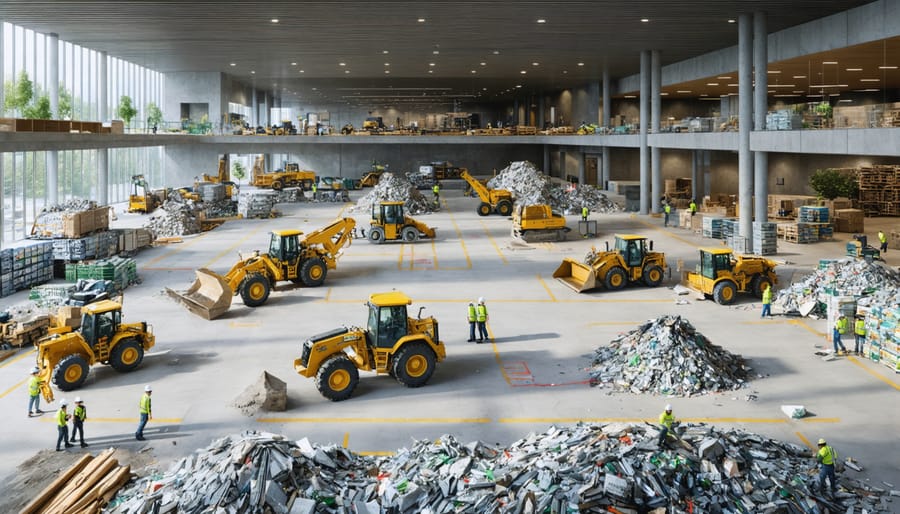The Materials and Resources (MR) category in LEED certification stands as a cornerstone of sustainable construction, driving transformative changes in how buildings source, utilize, and dispose of materials throughout their lifecycle. As construction waste continues to occupy valuable landfill space and raw material extraction depletes natural resources, LEED’s MR credits provide a strategic framework for implementing circular economy principles in building projects. Project teams pursuing LEED certification can earn up to 13 points through careful material selection, waste reduction strategies, and responsible procurement practices that prioritize environmental product declarations, material ingredient reporting, and locally sourced materials. This comprehensive approach not only enhances building sustainability but also creates lasting positive impacts on supply chains, manufacturing processes, and waste management systems across the construction industry. Understanding and effectively implementing MR credits has become essential for construction professionals aiming to deliver high-performance, environmentally responsible buildings while meeting increasingly stringent sustainability requirements from clients and regulatory bodies.
Key Components of LEED Materials and Resources Credits
Storage and Collection of Recyclables
The Storage and Collection of Recyclables prerequisite is a fundamental requirement for LEED certification, mandating dedicated areas for the collection and storage of recyclable materials. Projects must provide easily accessible collection points for paper, cardboard, glass, plastics, and metals at minimum. These areas should be sized appropriately based on the building’s occupancy and waste generation patterns.
For commercial buildings, a dedicated recycling room or loading dock area must be established, typically comprising 200-500 square feet depending on the facility’s size. Multi-tenant buildings require consolidated collection points on each floor, with a central storage area for building-wide materials. The recycling area should be clearly marked, well-ventilated, and protected from weather elements.
Implementation strategies include conducting a waste stream study to determine appropriate sizing, installing proper signage and bins, and developing a collection protocol. Building operators must establish relationships with recycling haulers and maintain documentation of recycling practices. Regular monitoring and adjustment of the recycling program ensure optimal performance and LEED compliance while promoting sustainable waste management practices throughout the building’s lifecycle.

Building Life-Cycle Impact Reduction
Building Life-Cycle Impact Reduction focuses on minimizing environmental impacts throughout a building’s existence, from construction through demolition. This credit encourages project teams to reuse existing building materials and implement circular economy principles to reduce waste and resource consumption.
Projects can earn points through several pathways, including historic building preservation, renovation of abandoned structures, or building and material reuse. The most common approach involves conducting a whole-building life-cycle assessment (LCA) that demonstrates a minimum 10% reduction in environmental impacts compared to a baseline building.
Key strategies include preserving existing structural elements, incorporating salvaged materials, and selecting products with documented environmental impacts. Teams must evaluate multiple impact categories, including global warming potential, ozone depletion, acidification, and eutrophication. Success requires early planning and collaboration between architects, engineers, and contractors to identify opportunities for material conservation and optimal environmental performance throughout the building’s life cycle.
Material Selection and Sourcing Strategies
Environmental Product Declarations
Environmental Product Declarations (EPDs) serve as transparent, standardized reports that communicate the environmental impacts of sustainable building materials throughout their lifecycle. In LEED v4.1, EPDs have become increasingly important for achieving Materials and Resources credits, offering up to 2 points for projects that utilize products with verified declarations.
To qualify for EPD credits, products must have independently verified Type III EPDs conforming to ISO 14025 and EN 15804 or ISO 21930. These declarations must include a cradle-to-gate scope at minimum, evaluating environmental impacts from raw material extraction through manufacturing.
Projects can earn points through two compliance paths:
1. Using 20 different permanently installed products from at least five different manufacturers that have product-specific Type III EPDs
2. Selecting products whose EPDs demonstrate impact reduction below industry averages in at least three impact categories
When implementing EPDs in material selection, teams should:
– Establish EPD requirements early in the specification process
– Maintain a product tracking system
– Verify that EPDs are current and valid
– Document calculations for impact reductions
– Consider the whole building lifecycle when evaluating environmental impacts
EPDs enable informed decision-making by providing quantifiable environmental impact data, helping project teams optimize material choices for both performance and sustainability goals.

Sourcing of Raw Materials
Under LEED v4.1, responsible sourcing of raw materials plays a crucial role in achieving certification points while promoting environmental stewardship. Projects can earn credits through sustainable material sourcing practices that emphasize transparency and environmental responsibility throughout the supply chain.
The guidelines focus on three key aspects: extraction methods, manufacturing processes, and transportation impacts. Projects must demonstrate that raw materials are obtained using responsible extraction practices, including proper land reclamation and minimal ecological disruption. Documentation requirements include Environmental Product Declarations (EPDs), Health Product Declarations (HPDs), and corporate sustainability reports from manufacturers.
Materials credits are awarded for using products that meet specific criteria, such as:
– Raw materials sourced within 100 miles of the project site
– Products with third-party verified chain of custody certification
– Materials with recycled content exceeding industry standards
– Responsibly harvested wood products certified by FSC or equivalent programs
To maximize points, project teams should prioritize suppliers who maintain transparent reporting practices and demonstrate commitment to environmental stewardship. This includes consideration of labor practices, waste reduction initiatives, and energy efficiency in extraction and processing operations. Early engagement with suppliers and manufacturers is essential to ensure proper documentation and compliance with LEED requirements.
Construction Waste Management

Waste Reduction Planning
Effective waste reduction planning is a cornerstone of LEED certification and sustainable construction practices. The process begins with a comprehensive construction waste management plan that outlines specific strategies for waste prevention, recycling, and disposal. Project teams must establish clear diversion goals, typically targeting 50-75% of construction waste to be diverted from landfills, aligning with LEED requirements.
Recent construction waste management innovations have introduced sophisticated tracking systems and on-site sorting protocols that significantly improve diversion rates. Key elements of a successful waste reduction plan include detailed material inventory management, identification of local recycling facilities, and establishment of clear responsibilities among team members.
Projects should implement a systematic approach to waste separation, designating specific containers for different materials such as metals, concrete, wood, and packaging materials. Documentation requirements include maintaining waste tracking logs, recycling facility receipts, and calculating diversion rates throughout the construction process. Regular training sessions for construction personnel ensure proper implementation of waste management protocols and maximize resource efficiency.
Documentation and Reporting
Proper documentation and reporting are crucial components of LEED certification for materials and resources credits. Project teams must maintain detailed records throughout the construction process, including material purchase documentation, waste diversion calculations, and product declarations from manufacturers. All waste management activities require comprehensive tracking, with contractors documenting the weight or volume of materials diverted from landfills through recycling, reuse, or salvage operations.
Required documentation typically includes waste hauling receipts, recycling facility records, and detailed spreadsheets tracking material destinations. For construction waste management, teams must maintain monthly reports showing diversion rates and provide verification from receiving facilities. Material ingredient reporting requires environmental product declarations (EPDs), health product declarations (HPDs), and manufacturer inventory reports.
Teams should implement a systematic approach to documentation, utilizing digital tracking systems and standardized forms to ensure consistency. Regular audits of documentation practices help maintain accuracy and completeness. Project managers must retain all documentation for a minimum of five years after project completion, as USGBC may request verification during the certification review process or for subsequent audits.
The LEED Materials and Resources category continues to evolve as the construction industry embraces more sustainable practices and innovative solutions. As we’ve explored throughout this article, successful implementation requires a comprehensive understanding of credit requirements, careful planning, and strategic material selection processes.
The future outlook for LEED materials and resources is promising, with emerging trends pointing toward increased adoption of circular economy principles, enhanced transparency in material sourcing, and greater emphasis on embodied carbon reduction. Industry leaders are developing more sophisticated tools and databases to track material impacts, while manufacturers are responding with expanded environmental product declarations and health product declarations.
Key takeaways for construction professionals include the importance of early planning for materials credits, the value of integrated design approaches, and the critical role of documentation throughout the construction process. Success in this category demands collaboration among project stakeholders, from architects and contractors to suppliers and waste management teams.
Looking ahead, we can expect continued refinement of LEED requirements to address urgent environmental challenges, particularly in areas such as carbon reduction and material health. Organizations that invest in developing robust materials and resources strategies now will be well-positioned for future LEED versions and evolving market demands.
The path to sustainable construction through LEED certification, while challenging, offers significant opportunities for innovation, cost savings, and environmental stewardship. By maintaining focus on these core principles and staying informed about industry developments, construction professionals can effectively navigate the materials and resources requirements while delivering high-performance, sustainable buildings.

